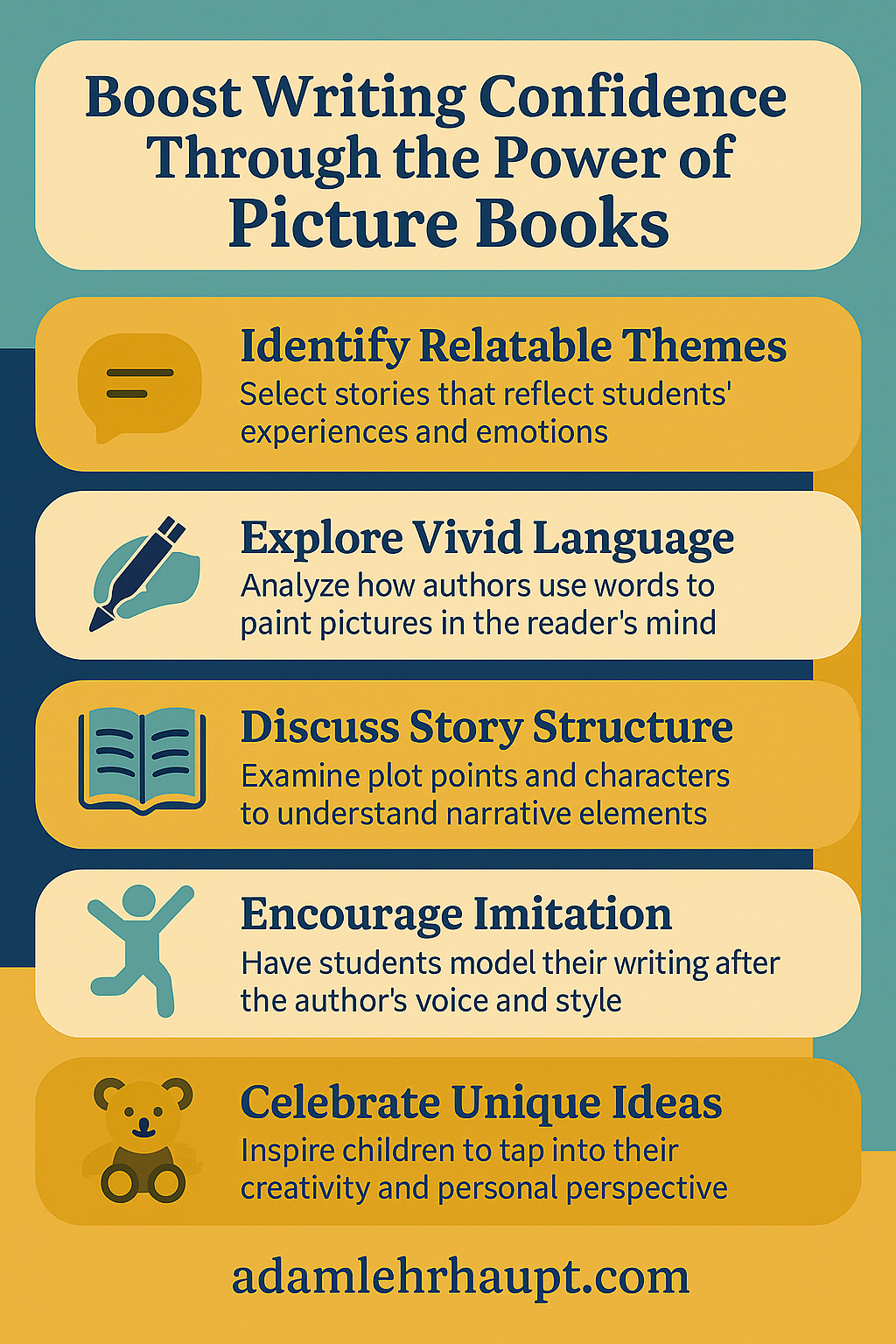When Kids Don’t Feel Like They Fit In
Ever notice how a child sits silently in corner A and you can’t tell whether they’re bored, shy, or just feel like the odd squirrel in the group? That’s why this post is packed with inclusive picture books for elementary writing confidence—because when students see themselves in stories, their voices grow stronger on the page too.
TL;DR:
Elementary teachers and librarians: use We Love Fishing! (Ariel Bernstein, illus. n/a) and Cats in Construction Hats (Sudipta Bardhan‑Quallen & Leeza Hernandez) alongside storytelling prompts like the character‑plot organizer, rule of three, and pun‑based inspiration to address inclusion, identity, teamwork, and belonging—and scaffold student writing confidence.
You’ll learn:
- How to use Inclusive Picture Books for Elementary Writing Confidence to Support SEL and Storytelling
- Practical lesson designs tied to character, plot, and group work
- Realistic teacher prep tips, differentiation, and cross‑curricular ideas
When Inclusion Meets Expression: Why Inclusive Picture Books for Elementary Writing Confidence Work
Young students crave connection, inclusion, and the feeling of belonging. Without it, curiosity shrinks, confidence dips, and writing gets stuck.
Enter two picture books with big heart and clever structure: We Love Fishing! by Ariel Bernstein and ill. by Marc Rosenthal and Cats in Construction Hats by Sudipta Bardhan‑Quallen and ill. by Leeza Hernandez. These stories explore group dynamics, identity, and teamwork using vibrant, sparse text that invites—and validates—every child.
In this post, you’ll discover how to build belonging-focused lessons that invite ALL voices into the storytelling circle—and tip‑off reluctant writers that their stories matter.
The Problem—When Feeling Different Means Staying Silent
Pain Point: Kids who feel “out of place” often tune out writing tasks or resist engagement.
Picture Book Solution: In We Love Fishing! (Bernstein, illus.), the character Squirrel resists fishing with friends—and immediately becomes the relatable odd one-out. As Sudipta says: “In any group … I am definitely the squirrel.” The simplicity invites readers to map their own experiences and feel seen.
Lesson Idea:
- Read the book aloud. Pause at crisis point and invite students to share a time they felt like “the squirrel.”
- Then ask: how did it feel? What changed?
- Turn the discussion into a quick drawing or caption writing.
Curriculum Tie-Ins:
- SEL/social awareness: recognizing how everyone has unique feelings and ways of belonging.
- Writing: personal narrative or poem structure.
Real Talk on Time & Effort:
- Read aloud (~5 min), then a 10‑minute reflection + drawing or caption. Minimal prep and high engagement.
Pro Tip from Real Visits:
Model your own “squirrel” moment first (yes, even as a grown-up). It normalizes vulnerability and gets kids to open up.
Check out these other great resources on how using picture books to support SEL builds empathy and classroom community in a predictable, manageable way (Using Picture Books for Social-Emotional Learning from Teacher Created Materials, Using Picture Books to Promote Activism & Equity).
The Problem—Teaching Collaboration, Inclusion & Identity
Pain Point: Teachers struggle to weave inclusion and teamwork into reading/writing without heavy resources.
Picture Book Solution: In Cats in Construction Hats (Bardhan‑Quallen & Hernandez, 2025), each cat excels at one colored-hat task—but only by pooling strengths (and chaos-causing rats) do they succeed together. Colors, jobs, and chaos become a metaphor for inclusion and teamwork. Many of the best inclusive picture books for elementary writing confidence feature team-based storylines where every voice matters, even the quiet ones.
Lesson Idea:
- Read aloud with color/shape scanning: “Who is the yellow cat? What tool are they holding?”
- Introduce a mini-group building activity: students each choose a color and role in a pretend “build” scenario.
- Reflection prompt: “How did different strengths help the team?”
Curriculum Connections:
- SEL: roles, teamwork, and respect for differences
- Cross-curricular: color/shape sorting in math; patterns in art
Real Talk:
Modeling and discussion take time (~15–20 min), but prep is low—just book, props/hands‑on sorting materials, and a quick group chart.
Pro Tips:
- For ELLs or younger learners, use color cards and pairing so everyone can participate.
- Ask: “If you were a cat on a crew, what would your hat be—and why?”
Research suggests picture books intentionally chosen can foster collaboration and empathy between classmates. Here’s some more to check out. (Picture Books That Inspire Collaboration from Edutopia, Picture Books to Support Social Emotional Learning from Lee & Low Books).
The Problem—Story Structure Without Stirring Anxiety
Pain Point: Emergent writers freeze when faced with “Write a story.” They freeze—ideas feel worthless.
Strategy Solution: using a Character‑Plot Graphic Organizer gives students a throwable scaffolding: name, trait(s), goal, obstacle. No overthinking allowed—just write.
Pair with Books:
- Use the squirrel character from We Love Fishing! Ask: What was Squirrel’s goal? What blocked her?
- Use one of the cats in Cats in Construction Hats: what did the cat want? And whom did it need to work with?
Lesson Flow:
- Show example of a character from book.
- Give students blank organizer and 5 minutes to sketch their own.
- Optional: pair-share and outline a quick mini-narrative.
Standards Tie:
Aligns with CCSS.ELA-LITERACY.RL.1.3 (describing character and events) and W.K.3 (writing to explain/compose) (Great SEL books from capstonepub.com, Browse a full year of lessons focused on critical character-building skills for social and emotional learning., Social skills books can help kindergarten, 1st grade, and 2nd grade students from Proud to Be Primary)
Real Talk: Prep is minimal; planning takes 15 min. But some students will struggle to identify a “goal”—give them sentence frames: “My character wants… because…,” “One thing stopping them is…”
The Problem—Engagement Wanes Without Whimsy & Word Play
Pain Point: Kids disengage when writing feels boring or mechanical.
Story Spark Tools: From our episode:
- Rule of Three prompts (“fail twice, win on third try,” or three friends, three tries, etc.)
- Pun-based inspiration from kids’ t-shirt slogans (“happy bar, clappy bar”)
Lesson Implementation:
- Read aloud and point out repetition in Cats in Construction Hats (“yellow cat. green hat”) to spark rhyme exploration.
- Invite kids to write a 3-part story about teamwork or belonging (“Three cats worked, failed twice, succeeded third time”)—tie back to rule of three.
- Display a punny t-shirt slogan or image and ask students to write four-line poems or short narratives around it—encouraging visual/word connections.
Differentiation:
- Younger writers can draw, sequence with captions.
- Older/more confident can write full 4-sentence stories with transitions (“first,” “then,” “finally”).
Real Talk:
This is low-prep, high payoff. Most students latch onto the pattern and produce something. Teach expectations clearly: it’s playful, not graded for perfection.
🧠 Pro Tip: Use inclusive picture books for elementary writing confidence as “mentor texts” during shared writing. Let kids borrow story patterns that highlight collaboration or overcoming self-doubt.
📚 Bonus Ideas: Cross-Curricular & Family Extension
- Community Mural: After reading Cats in Construction Hats, students draw and label a school teamwork scene using color-coded roles (like cats). Integrate art and literacy.
- “Belonging Bookshelf”: Create a classroom display of read-alouds addressing identity and inclusion—include We Love Fishing!, The Snowy Day (Ezra Jack Keats), Danbi Leads the School Parade (Anna Kim). Encourage families to add their own stories.
- Home Story Sparks: Send home a mini‑prompt: “My group of family or friends had a “squirrel moment”—describe it in three steps or draw it.” Supports family talk and writing across contexts.
- Music & Movement: Use the rule of three in a group cheer or chant (e.g. “We build, we crash, we build again!”) and then write about it.
- STEAM Tie: After Cats in Construction Hats, have kids engineer a simple structure with blocks, identify obstacles, and write a short caption sequence: goal, challenge, solution.
Still need even more great ideas? Download the Ultimate Creative Writing Lesson Toolkit.
✅ Conclusion: Books + Identity + Structure = Story Confidence
When kids see stories about squirrels, cats in hats, or weird jobs—but all characters finding their place—they realize one truth: stories can include you.
By anchoring lessons in books that reflect inclusion and teamwork, paired with easy structures (organizer, rule of three, pun-sparks), you invite every child into the writing process with low stakes and lots of belonging.
With just a few inclusive picture books for elementary writing confidence and a sprinkle of creativity, you can help every student feel like their story belongs—on the page and in the classroom. Want to dive deeper? Check out this post on empowering students with picture books.
Give it a shot—share the post with colleagues, sign up for more lesson ideas on my newsletter (free prompts + book recs monthly), and let’s bring inclusive storytelling into every K‑2 classroom.
Frequently Asked Questions (FAQ)
How can I adapt these activities for K learners or ELLs?
Use picture cards, draw-and-label frames, simple pairing, and rely more on discussion than extended writing.
Do I need full class sets of the books?
No—read aloud and then display images or project pages. Small copies or digital excerpts work fine for reflection.
What if students struggle with the organizer prompts?
Model first with your own example. Provide sentence starters: “My character is… They want… Something blocks them… Then…”
How much prep time do I need?
How much prep time do I need?
Minimal—read aloud takes ~5 minutes, planning and activity are ~10–15 minutes each. Total class block under 45 minutes.
How do I assess writing tied to SEL?
How do I assess writing tied to SEL?
Source reflection: Did the student connect personal identity or social feeling to text? Use checklist for organizer components and student voice.
How do these lessons meet SEL goals?
They support CASEL competencies: self-awareness, social awareness, relationship skills, empathy, and responsible decision-making (Teacher Created Materials, teachingwithamountainview.com).
Can I include multicultural picture books too?
Can I include multicultural picture books too?
Absolutely. Titles like Danbi Leads the School Parade (Anna Kim) and The Snowy Day (Ezra Jack Keats) broaden representation and belonging discussions.
How do I find the best inclusive picture books for elementary writing confidence?
Look for titles with diverse characters, collaborative storylines, or emotional growth arcs. Books like We Love Fishing! by Ariel Bernstein and illustrator Marc Rosenthal are great starting points.




